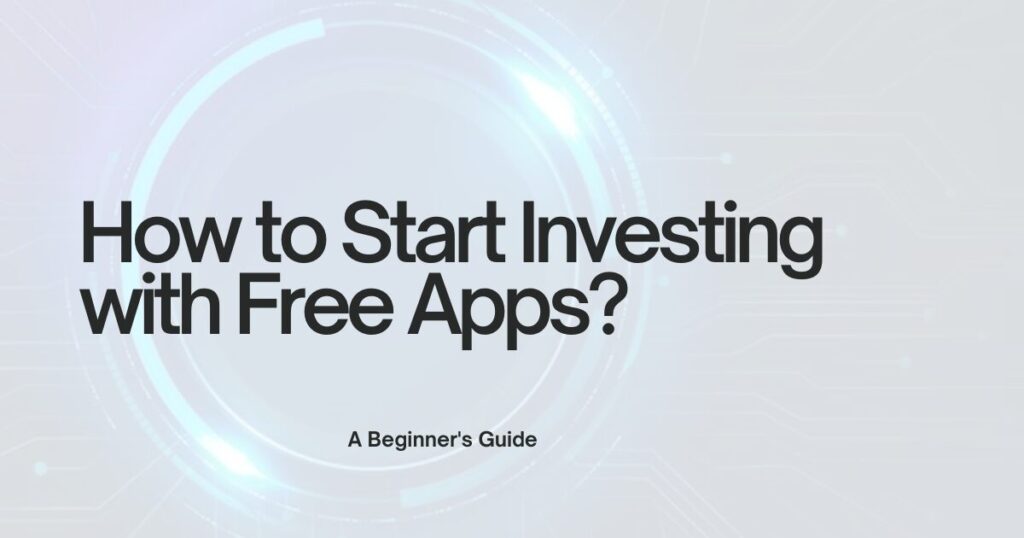
Investment apps for beginners offer commission-free stock and ETF trading, low or no minimum deposits, and user-friendly interfaces. Top options include Robinhood, Fidelity, SoFi Invest, and Charles Schwab for active trading, while Betterment and Acorns excel at automated investing. Most platforms let you start with $1-$10, making investing accessible to everyone regardless of budget.
You’ve saved $100 and you’re ready to start investing. But when you open your first brokerage app, you’re hit with confusing charts, unfamiliar terms, and dozens of investment options. Should you pick individual stocks? What’s an ETF? And why does everyone keep talking about fractional shares?
The good news? Modern investment apps have stripped away most of that complexity. You don’t need thousands of dollars or a finance degree anymore. Today’s platforms let you start with pocket change, guide you through your first trades, and some even invest for you automatically.
This guide walks you through everything you need to know about choosing your first investment app, understanding how they work, and actually starting to build wealth—without the overwhelm.
What Makes an Investment App Right for Beginners?
Not all investment apps work the same way. Some cater to experienced traders who want advanced charting tools and options contracts. Others focus on helping first-timers dip their toes in the market without getting lost in the weeds.
The best beginner apps share three core features. First, they charge zero commissions on basic stock and ETF trades. Remember when every trade cost $10? Those days are gone. Major platforms like Fidelity, Charles Schwab, and Robinhood eliminated trading fees years ago, making it financially practical to invest small amounts regularly.
Second, they offer fractional shares. This feature lets you buy a slice of expensive stocks with whatever money you have. Want to own Amazon or Google but don’t have $3,000 for a single share? With fractional investing, you can buy $10 worth instead. SoFi, Robinhood, and Public all support this feature, making it easier to build a diversified portfolio on a tight budget.
Third, beginner-friendly apps keep the interface clean and straightforward. You shouldn’t need to watch YouTube tutorials just to place your first trade. The best platforms use simple language, provide educational content, and offer clear guidance without drowning you in technical jargon.
Account minimums matter too. Some investment apps require you to deposit $500 or more just to open an account. Others let you start with $1. If you’re testing the waters or building your emergency fund at the same time, low minimums give you flexibility. Fidelity, Robinhood, and Webull all have zero account minimums, while robo-advisors like Betterment let you start with as little as $10.
Free Stock Trading Apps vs Robo-Advisors: Which Path Should You Take?
You have two main approaches when starting out: self-directed trading apps or automated robo-advisors. Understanding the difference helps you pick the right tool for your personality and goals.
Self-directed apps give you control. You decide which stocks or ETFs to buy, when to sell, and how to allocate your money. This approach works well if you want to learn about investing, enjoy researching companies, or prefer making your own decisions. Platforms like Robinhood, Webull, and Public offer streamlined interfaces that make buying stocks as simple as ordering food on your phone.
The downside? You’re responsible for building a balanced portfolio. New investors often make emotional decisions—buying high when everyone’s excited and selling low during market dips. Without guidance, you might overload on risky stocks or forget to diversify beyond tech companies.
Robo-advisors take a different approach. You answer questions about your goals, timeline, and risk tolerance. The platform then builds and manages a diversified portfolio for you using ETFs. Betterment, Wealthfront, and M1 Finance automatically rebalance your investments and some offer tax-loss harvesting to reduce your tax bill.
This hands-off method suits people who want to invest but don’t want to become investment experts. You pay a small management fee—typically 0.25% annually—but you save time and remove the emotional element from investing. Your portfolio stays on track whether the market’s up, down, or sideways.
Many beginners start with a robo-advisor to learn the basics, then add a self-directed account later once they’re comfortable. There’s no wrong answer here. Pick the approach that matches how involved you want to be.
Top Investment Apps for Active Stock Trading
If you want to pick your own investments, these platforms make it straightforward to buy stocks, ETFs, and other securities without paying commissions.
Robinhood pioneered the commission-free trading movement and remains popular among beginners. The app’s clean design makes it easy to browse stocks, read analyst ratings, and place trades in seconds. You can invest in over 10,000 stocks and ETFs, plus trade cryptocurrencies and options. Fractional shares start at $1, and there’s no account minimum. The catch? Robinhood lacks robust research tools, so you’ll need to do your homework elsewhere. The $5 monthly Robinhood Gold membership adds enhanced features like professional research and higher instant deposit limits.
Fidelity balances simplicity with substance. You get commission-free trades on stocks and ETFs, access to thousands of mutual funds, and one of the best research platforms in the industry. The mobile app feels modern without being oversimplified, and customer service consistently ranks at the top. Fidelity lets you invest in fractional shares starting at $1, and you can open an account with no minimum. For beginners who want a platform they won’t outgrow, Fidelity checks every box.
Charles Schwab offers similar quality with two separate apps—Schwab Mobile for everyday investors and thinkorswim for advanced traders. New investors appreciate the extensive educational resources, responsive customer support, and integration with Schwab’s other services. The platform supports fractional shares and has no account minimums. If you bank with Chase, you might prefer J.P. Morgan Self-Directed Investing, which connects all your accounts in one interface.
SoFi Invest appeals to younger investors building their financial ecosystem. Beyond commission-free trading and fractional shares starting at $5, SoFi members get access to financial planners, career coaching, and networking events. The app supports stocks, ETFs, and cryptocurrency, though it lacks some advanced features like mutual funds and bonds. If you’re already using SoFi for banking or student loans, consolidating everything makes sense.
Webull targets tech-savvy beginners who want more advanced charting without paying for it. The platform offers extended trading hours, level II market data, and paper trading where you practice with virtual money before risking real cash. Commission-free trading covers stocks, ETFs, and options. The interface has more features than Robinhood but remains approachable for newcomers willing to invest time learning the tools.
Best Robo-Advisors for Hands-Off Investing
If you’d rather automate your investments and focus on other priorities, these robo-advisors handle the heavy lifting while you contribute regularly and watch your portfolio grow.
Betterment pioneered the robo-advisor model and remains the strongest choice for beginners. You can start with just $10, and the platform charges 0.25% annually to manage your money. After answering a few questions about your goals and risk tolerance, Betterment builds a globally diversified portfolio using low-cost ETFs. The platform automatically rebalances your investments and offers tax-loss harvesting on taxable accounts. You also get goal-planning tools that show how much you need to save for retirement, a house down payment, or other targets. For an additional fee, you can access human financial advisors.
Wealthfront competes closely with Betterment, offering similar automation for the same 0.25% annual fee. The minimum to start is $500, slightly higher than Betterment. Where Wealthfront shines is in its additional features—you get a high-yield cash account, stock investing alongside your automated portfolio, and sophisticated tax strategies including direct indexing for larger accounts. The platform works especially well for people who want both automated investing and the ability to buy individual stocks.
Acorns takes a unique approach by rounding up your everyday purchases and investing the spare change automatically. Link your debit or credit card, and Acorns invests the difference each time you spend money. A $4.50 coffee becomes $5, and the extra $0.50 goes into your investment account. This micro-investing strategy helps people who struggle to save consistently. Plans start at $3 monthly, which can eat into returns on small balances, but the automated savings mechanism proves powerful for building the habit.
M1 Finance blends robo-advisor automation with customization. The platform offers pre-built portfolios called “Pies” based on different strategies and goals. You can use these as-is or customize them by adding or removing stocks and ETFs. Once you’ve built your Pie, M1 automatically invests new contributions according to your chosen allocation. There are no management fees beyond the underlying ETF costs, and you can open an account with $100. This hybrid approach appeals to beginners who want some control without managing everything manually.
Fidelity Go provides automated portfolio management from a trusted name in finance. The service is free for accounts under $25,000, then charges 0.35% annually on larger balances. You need at least $10 to start, and Fidelity Go uses its own zero-expense-ratio mutual funds to build your portfolio. The trade-off is fewer features than Betterment or Wealthfront—no tax-loss harvesting, for example. But if you prefer keeping your investments with an established financial institution, Fidelity Go delivers solid automation at a competitive price.
People Also Love to Read This: Which Credit Cards Are Best for College Students?
Understanding Fees and What They Really Cost You
Commission-free trading sounds great, but investment apps still make money somehow. Understanding the fee structure helps you pick the most cost-effective option and avoid surprises.
Most platforms generate revenue through payment for order flow, earning small amounts when routing your trades to market makers. This doesn’t directly cost you anything, though some argue it creates conflicts of interest. More relevant for beginners are the fees you’ll actually pay or potentially pay.
Options trading typically includes per-contract fees, usually $0.50 to $0.65 per contract. If you’re sticking with stocks and ETFs, you won’t encounter these charges. Mutual funds may carry transaction fees at some brokers, though most offer thousands of no-transaction-fee options. Always check before buying a mutual fund to avoid $50 surprise charges.
Robo-advisors charge management fees, usually 0.25% to 0.35% of your account balance annually. On a $1,000 account, that’s $2.50 to $3.50 per year. As your balance grows, these fees grow too—$250 to $350 annually on a $100,000 account. That’s still cheaper than human financial advisors who typically charge 1% or more.
Every investment fund—whether you buy it through a self-directed app or robo-advisor—charges an expense ratio. This ongoing fee covers the fund’s operating costs. An ETF with a 0.03% expense ratio costs $3 annually per $10,000 invested. Total market index funds from Vanguard and Fidelity keep expense ratios extremely low, often below 0.05%. Actively managed funds might charge 0.50% to 1% or more.
The real cost of fees compounds over time. A 1% annual fee might not sound like much, but over 30 years, it can reduce your final balance by 20% or more compared to a 0.25% fee. That’s why favoring low-cost index funds and platforms with minimal fees matters—you keep more of your investment returns.
Some platforms charge account maintenance fees or inactivity fees if you don’t trade regularly. Most major apps have eliminated these, but always read the fine print. You don’t want to discover your account charges $50 annually just for existing.
How to Actually Get Started: Your First 30 Days
You’ve picked an app. Now what? Here’s a practical roadmap for your first month of investing.
Start by downloading the app and creating your account. You’ll need to provide personal information including your Social Security number, employment details, and bank account for funding. The approval process typically takes a few hours to a day. Don’t rush this step—double-check that your information is accurate to avoid delays.
While waiting for approval, educate yourself using the app’s learning resources. Most platforms offer articles, videos, and tutorials explaining investing basics. Focus on understanding key concepts: what stocks and ETFs are, how the market works, and the difference between market and limit orders. You don’t need to become an expert overnight, but grasping the fundamentals prevents costly mistakes.
Once approved, make your first deposit. Starting small is fine—there’s no requirement to invest everything at once. Many experts suggest beginning with an amount you’re comfortable potentially losing as you learn. $50, $100, or $500 are all reasonable starting points. Set up automatic transfers if the app supports them, even if it’s just $10 weekly. Consistent contributions matter more than large lump sums.
For self-directed apps, consider starting with a broad market ETF rather than individual stocks. An S&P 500 index fund like VOO or SPY gives you instant diversification across 500 large US companies. This reduces risk while you learn the ropes. As you gain confidence, you can branch into individual stocks or sector-specific ETFs.
If using a robo-advisor, complete the questionnaire honestly. Your answers about risk tolerance and goals determine your portfolio allocation. Don’t exaggerate your comfort with risk or you might end up in a portfolio that keeps you awake during market downturns. Being conservative initially is smarter than panicking and selling during your first market dip.
Monitor your investments, but don’t obsess. Checking your balance hourly fuels anxiety and impulsive decisions. Successful investing requires patience and the discipline to stay invested when markets fluctuate. Set a schedule—maybe checking weekly or monthly—and resist the urge to constantly refresh.
Finally, increase your knowledge gradually. Read investing books, follow reputable financial news sources, and learn from others’ experiences. Many apps have community features where you can observe what experienced investors are doing, though avoid blindly copying their trades. Building your own understanding creates sustainable, long-term success.
Common Mistakes and How to Avoid Them
New investors repeatedly make the same errors. Recognizing these patterns helps you sidestep them.
Chasing trends ranks as the most common mistake. A stock doubles in price, social media buzzes about it, and new investors pile in at the peak. Then the price crashes and they’re left with losses. Remember that if everyone’s talking about an investment, you’re probably late to the party. Focus on long-term growth rather than trying to catch every hot stock.
Emotional trading destroys wealth. Buying when you feel excited and selling when you’re scared means buying high and selling low—the opposite of what works. The stock market will have bad days, bad weeks, and even bad years. Successful investors stick to their strategy through the volatility. If market swings cause you genuine stress, a robo-advisor’s automated approach might serve you better.
Lack of diversification concentrates risk unnecessarily. Putting all your money into one stock or sector means that if that investment fails, your entire portfolio fails too. Spread investments across different companies, industries, and even asset types like bonds. ETFs make diversification simple by holding hundreds or thousands of securities in a single investment.
Ignoring fees seems minor until you calculate their long-term impact. Always check expense ratios before buying funds and understand any trading costs. Even small differences in fees compound significantly over decades of investing. Choosing a fund with a 0.05% expense ratio instead of 0.75% could mean tens of thousands of dollars more at retirement.
Timing the market rarely works, even for professionals. You can’t consistently predict when to buy at the bottom or sell at the top. Rather than trying, invest regularly regardless of market conditions. This approach, called dollar-cost averaging, means you’ll buy more shares when prices are low and fewer when prices are high, averaging out your cost over time.
People Also Love to Read This: What Are Today’s Mortgage Refinance Rates?
Frequently Asked Questions
What’s the easiest investment app for someone who’s never invested before?
Betterment and Acorns offer the smoothest experience for complete beginners because they automate everything. Answer a few questions, fund your account, and they handle the rest. You don’t need to understand different investment types or build a portfolio—the platform does it for you. For people who want to learn by actively trading, Robinhood provides the simplest interface with straightforward buy and sell buttons, though you’ll need to research which investments to choose.
How much money do I actually need to start investing?
You can start investing with as little as $1 on many platforms. Fidelity, Robinhood, SoFi, and Public all support fractional shares, letting you invest small amounts in expensive stocks. Robo-advisors like Betterment require just $10 to begin. While you can start with tiny amounts, investing at least $50-100 initially makes more sense—it gives you enough to buy a diversified ETF or let a robo-advisor build a proper portfolio. The key is starting with whatever you can afford and adding to it consistently, not waiting until you have thousands saved.
Why are these apps free? How do they make money?
Investment apps generate revenue through several methods that don’t directly charge you per trade. Many earn from payment for order flow, receiving small fees from market makers who execute your trades. They also profit from interest on your uninvested cash sitting in your account, and some offer premium subscriptions with advanced features. Robo-advisors charge management fees as a percentage of your balance. The absence of trading commissions doesn’t mean the companies operate as charities—they’ve simply shifted to business models that work without charging you directly for each transaction.
Final Thoughts
Starting to invest used to require expensive brokers, complex paperwork, and substantial minimum deposits. Modern investment apps have demolished those barriers. Whether you choose a hands-on approach with platforms like Fidelity and Charles Schwab or prefer automated investing through Betterment and Wealthfront, the tools exist to build real wealth starting with whatever money you have today.
The hardest part isn’t picking the perfect app—it’s actually beginning. Markets will fluctuate, you’ll make mistakes, and you’ll question your decisions during downturns. That’s normal. The investors who succeed aren’t the ones who never experience doubt; they’re the ones who start anyway, learn as they go, and keep investing through uncertainty.
Open an account this week. Invest a small amount. Then do it again next week. That simple habit, repeated consistently, builds financial security over time. Your future self will thank you for starting today rather than waiting for the perfect moment that never comes.



